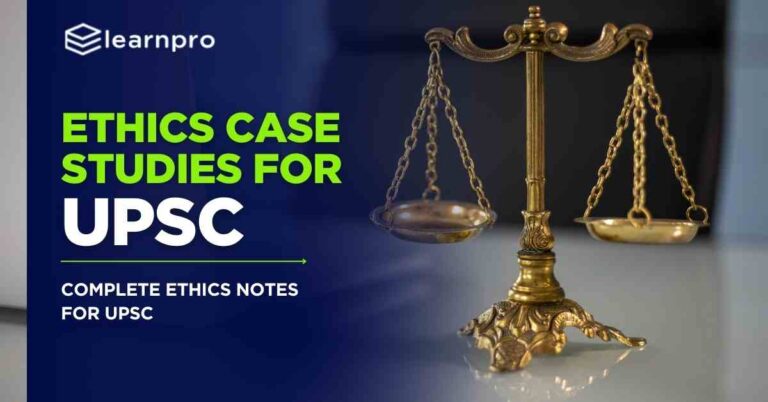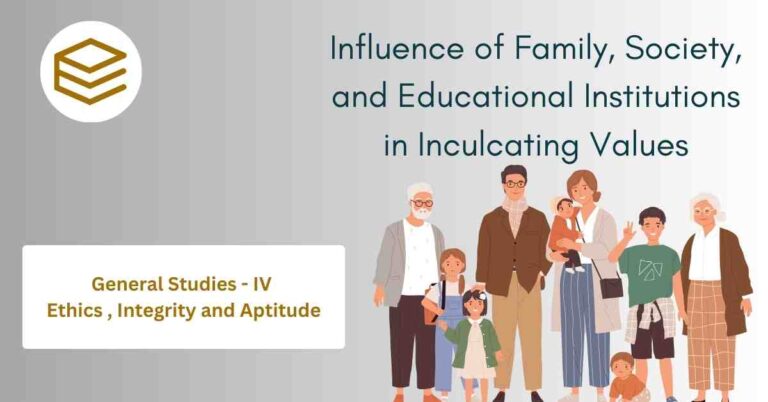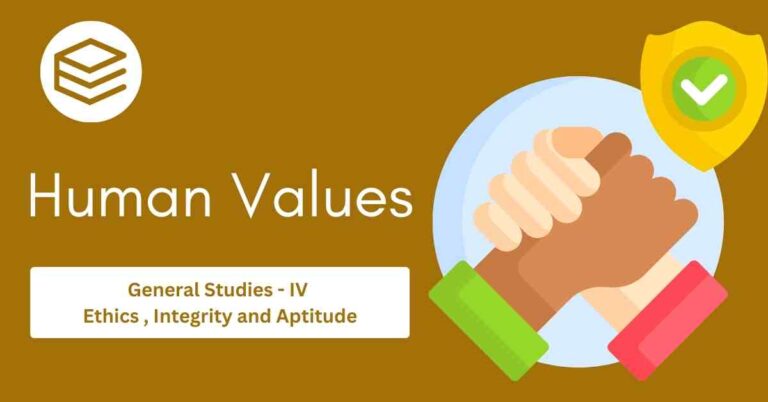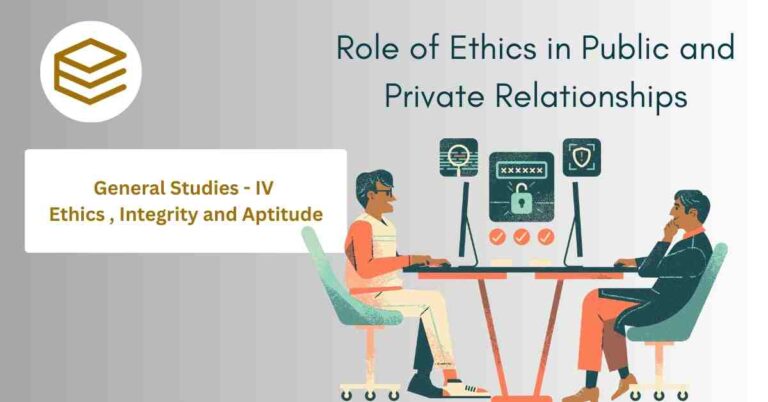December 8, 2025 10:34 pm
Ethics serves as the moral foundation of human society, governing behavior and decision-making. It is the bedrock upon which trust, cooperation, and justice are built, and it guides individuals and institutions in navigating complex choices. Ethics balances personal aspirations with collective welfare, ensuring fairness and accountability. For civil servants, ethics acts as a vital compass, ensuring transparent and inclusive governance.
In this discussion, we delve deeper into the essence, determinants, and consequences of ethics, enriching our understanding of its pivotal role in human actions.
1. Essence of Ethics
The essence of ethics lies in its ability to guide moral judgment and action. Ethics is not confined to a rigid set of rules but is a dynamic framework that helps individuals and societies address evolving challenges.
Definition of Ethics
- Ethics refers to a system of moral principles that govern human behavior. It provides individuals with a lens to assess their responsibilities, choices, and consequences.
- Ethics is both intrinsic (emerging from conscience and values) and extrinsic (shaped by societal norms, laws, and institutions).
Essence Explained
1.1 Guiding Principles of Life
- Ethics provides a moral compass for individuals to distinguish right from wrong.
- It is applicable across personal relationships, professional conduct, and public service.
- Example: A bureaucrat adhering to ethical principles ensures fairness while allocating resources for public welfare.
- Ethics transcends mere compliance with laws by emphasizing integrity and personal responsibility.
1.2 Harmony Between Self and Society
- Ethics aligns personal interests with societal welfare, fostering cooperation and peace.
- It resolves conflicts by emphasizing compassion, equity, and fairness.
- Example: Paying taxes honestly contributes to national development and public services, benefiting society as a whole.
1.3 Foundation for Trust
- Ethical behavior builds trust and credibility in relationships, institutions, and governance.
- Trust is the cornerstone of productive and harmonious societies.
- Example: Citizens trust transparent governments, strengthening democratic systems.
1.4 Framework for Justice
- Ethics underpins systems of justice, ensuring fairness and equality.
- It provides a moral rationale for laws and policies designed to address inequities.
- Example: Mahatma Gandhi’s principle of non-violence demonstrated how ethical action could drive justice and freedom.
1.5 Intrinsic to Human Behavior
- Ethics is rooted in human nature and conscience, arising from interactions and coexistence.
- It helps resolve moral dilemmas where laws may fall short.
- Example: An environmentalist refusing to condone illegal deforestation exemplifies ethical behavior even in the absence of strict enforcement.
Relevance in Governance
- Ethics ensures that governance is inclusive, transparent, and accountable.
- It prevents corruption and fosters sustainable development.
- Example: The Right to Information (RTI) Act ensures transparency, empowering citizens and reducing unethical practices in public administration.
2. Determinants of Ethics
Ethics is not innate alone; it is shaped by a combination of personal values, societal norms, and institutional frameworks. These determinants interact dynamically, influencing an individual’s moral outlook and decisions.
2.1 Personal Determinants
Values and Beliefs
- Personal values such as honesty, compassion, and integrity form the foundation of ethical conduct.
- Example: A teacher with a strong belief in equality treats all students fairly, fostering an inclusive learning environment.
Upbringing and Family Influence
- Early experiences shape an individual’s ethical framework.
- Families instill foundational principles of respect, responsibility, and fairness.
- Example: Parents who value truthfulness influence children to prioritize honesty throughout life.
Conscience
- The inner sense of right and wrong guides individuals in moral decision-making.
- Conscience often serves as the ultimate checkpoint for actions.
- Example: Whistleblowers, acting on their conscience, expose corruption despite personal risks.
Emotional Intelligence
- Emotional intelligence, or the ability to manage emotions effectively, plays a vital role in ethical behavior.
- A leader with high emotional intelligence demonstrates empathy and fairness, fostering trust and harmony.
- Example: Resolving workplace conflicts through emotional intelligence ensures ethical decision-making.
2.2 Societal Determinants
Cultural Norms and Traditions
- Societal expectations, cultural norms, and traditions influence ethical behavior.
- Example: In Indian culture, the principle of Vasudhaiva Kutumbakam (the world as one family) promotes inclusivity and harmony.
Religion and Spirituality
- Religious teachings often form the ethical foundation for individuals and communities.
- Example: The Jain principle of Ahimsa (non-violence) inspires ethical living and decision-making.
Education
- Education fosters moral reasoning and a sense of social responsibility.
- Example: Environmental education encourages individuals to adopt sustainable practices.
Peer Influence
- The groups and communities individuals interact with shape their ethical outlook.
- Example: Corporate cultures emphasizing ethical practices inspire employees to act with integrity.
2.3 Institutional Determinants
Laws and Regulations
- Legal frameworks establish minimum ethical standards, enforcing accountability.
- Example: Anti-corruption laws deter unethical behavior in governance.
Codes of Conduct
- Professional ethics, such as the Hippocratic Oath, provide moral guidelines for specific fields.
- Example: Doctors prioritize patient welfare above all else.
Leadership and Role Models
- Leaders set ethical benchmarks that influence institutions and societies.
- Example: Dr. A.P.J. Abdul Kalam exemplified integrity, inspiring ethical leadership in governance.
Media and Technology
- Media highlights social issues and promotes accountability, influencing societal ethics.
- Example: Investigative journalism exposing corruption fosters ethical governance.
3. Consequences of Ethics in Human Actions
The impact of ethics on individuals and society is profound. Ethical behavior fosters trust, harmony, and development, while unethical actions can lead to discord, inequality, and degradation.
3.1 Positive Consequences
Trust and Credibility
- Ethical practices build trust in relationships and institutions.
- Example: Transparent governance strengthens public confidence in democratic systems.
Social Harmony
- Adherence to ethics reduces conflicts and promotes peace.
- Example: Inclusive policies prevent societal unrest.
Sustainable Development
- Ethics drives long-term, inclusive development.
- Example: Eco-friendly industrial practices ensure environmental sustainability.
Enhanced Decision-Making
- Ethical frameworks lead to rational, morally sound decisions.
- Example: Refusing bribes strengthens institutional integrity and public trust.
Reduction in Corruption
- Ethical governance minimizes corruption, ensuring equitable resource distribution.
- Example: Digitization of public services reduces opportunities for unethical practices.
3.2 Negative Consequences of Unethical Actions
Erosion of Trust
- Unethical actions destroy trust in individuals and institutions.
- Example: Governance scandals erode public confidence.
Conflict and Discord
- Ethical lapses lead to societal unrest and reduced cooperation.
- Example: Discrimination in workplaces causes tension and reduced morale.
Environmental Degradation
- Exploiting resources unethically results in ecological crises.
- Example: Illegal mining causes deforestation and biodiversity loss.
Economic Inequality
- Corruption widens the gap between rich and poor, undermining social equity.
- Example: Misuse of public funds diverts resources from welfare programs.
4. Ethical Dilemmas and Decision-Making
While ethics often provides clarity, there are situations where moral choices become complicated, leading to ethical dilemmas. Ethical dilemmas occur when individuals face two or more conflicting values or principles, and choosing one often means compromising another.
4.1 Examples of Ethical Dilemmas
- Public Administration: A civil servant must decide whether to grant a lucrative contract to an influential but unqualified bidder under political pressure or risk career repercussions by awarding it to a deserving but less connected entity.
- Healthcare: A doctor has to allocate a single ventilator between two critically ill patients, knowing one has a better survival chance while the other is the primary breadwinner for their family.
- Environmental Management: A policymaker must balance industrial development that boosts economic growth with the long-term ecological damage it might cause.
4.2 Approaches to Resolving Ethical Dilemmas
Consequentialism (Outcome-Based Approach)
- Core Idea: Actions are judged by their outcomes; the ethically right decision is the one that produces the greatest good for the greatest number.
- Strengths:
- Promotes utilitarian principles.
- Focuses on societal benefits.
- Example: Prioritizing vaccine distribution during a pandemic to high-risk groups first maximizes public health impact.
- Strengths:
Deontology (Duty-Based Approach)
- Core Idea: Focuses on adherence to rules and duties rather than outcomes. Ethical actions are those that align with universal moral principles.
- Strengths:
- Emphasizes justice and equality.
- Safeguards rights irrespective of results.
- Example: Enforcing environmental laws to protect endangered species, even if it affects businesses negatively, reflects deontological ethics.
- Strengths:
Virtue Ethics (Character-Based Approach)
- Core Idea: Focuses on the character and intentions of the decision-maker. The morally right choice is one that reflects virtues like honesty, courage, and compassion.
- Strengths:
- Cultivates moral growth.
- Builds long-term trust and credibility.
- Example: A leader who prioritizes the ethical treatment of employees during financial crises exemplifies virtue ethics.
- Strengths:
Integrated Approach
- Often, ethical dilemmas require blending frameworks to arrive at a balanced resolution.
- Example: In policymaking, combining deontological principles (upholding laws) with consequentialist reasoning (maximizing societal welfare) ensures decisions are both principled and pragmatic.
4.3 Tools for Ethical Decision-Making
- Ethical Codes: Pre-established standards like civil service conduct rules or professional oaths help guide actions.
- Grievance Mechanisms: Robust systems for addressing ethical concerns provide clarity in ambiguous situations.
- Stakeholder Analysis: Understanding the impact of decisions on all stakeholders ensures inclusivity and fairness.
- Dialogue and Deliberation: Consulting peers, experts, or communities often provides diverse perspectives, reducing biases in decision-making.
5. Case Study : Refusal to Accept Bribes in Public Administration
Scenario
A District Magistrate (DM) in a rapidly urbanizing district in India was overseeing a large infrastructure project aimed at building affordable housing for low-income groups. During the land acquisition process, the DM encountered a politically influential real estate developer who sought to illegally acquire part of the land earmarked for public housing. The developer offered a substantial bribe, coupled with threats of political repercussions if the request was denied. Additionally, local political leaders pressured the DM to expedite approvals for the developer’s private project, which violated environmental norms.
Ethical Dilemma
The DM faced conflicting ethical challenges:
- Uphold the law and resist corruption, risking political backlash and career consequences.
- Accept the bribe or yield to political pressure, compromising integrity and the welfare of the intended beneficiaries of the housing project.
Resolution
- Refusal to Compromise on Integrity: The DM refused the bribe and declined to favor the developer. To mitigate potential backlash, they documented all interactions meticulously, including the bribe offer and political interference.
- Transparency in Governance: The DM involved the public through community meetings, explaining the project’s importance and challenges. This public engagement built support and reduced the influence of vested interests.
- Legal and Administrative Action: Leveraging whistleblower protection provisions, the DM reported the matter to anti-corruption agencies and the Chief Secretary of the state. The developer was investigated, and the illegal attempts were exposed.
- Collaboration with Civil Society: Partnering with local NGOs, the DM ensured independent monitoring of the land acquisition process, enhancing public confidence.
Outcomes
- The project proceeded without further delays, providing housing for over 10,000 low-income families.
- The DM’s proactive approach deterred future attempts at corruption.
- Public support safeguarded the DM from political fallout, highlighting the strength of ethical leadership.
Analysis
This case exemplifies how ethical decision-making can resolve complex dilemmas in governance. The DM’s actions demonstrate:
- Integrity in Public Service: Ensuring fairness despite external pressures.
- Accountability: Upholding transparency and engaging stakeholders.
- Courage in Adversity: Making principled decisions in the face of personal and professional risks.
Such cases highlight the broader implications of ethical behavior, reinforcing trust in public institutions and safeguarding societal interests.
6. Historical Perspectives on Ethics from Key Thinkers
Ethics, as a guiding principle for human behavior, has been a subject of philosophical inquiry for centuries. The works of thinkers like Aristotle, Immanuel Kant, and Mahatma Gandhi provide timeless insights into understanding and applying ethics in personal and societal contexts. Each thinker brings a unique lens, offering diverse approaches to moral reasoning.
6.1 Aristotle’s Virtue Ethics: Character is Key

- Core Philosophy: Aristotle viewed ethics as the pursuit of a good life, one where individuals achieve Eudaimonia, or human flourishing. For Aristotle, ethics was less about rigid rules and more about cultivating virtues—qualities like courage, honesty, and temperance.
- The Golden Mean: Central to Aristotle’s ethics is the idea of the “Golden Mean”, which argues for moderation. Virtue lies between two extremes:
- Example: Courage is the balance between recklessness and cowardice.
- Modern Relevance: Virtue ethics remains relevant in leadership and governance. Ethical leaders who prioritize integrity and empathy can create trust-based systems.
- Example: A bureaucrat practicing fairness in public policy embodies Aristotle’s approach by balancing compassion with justice.
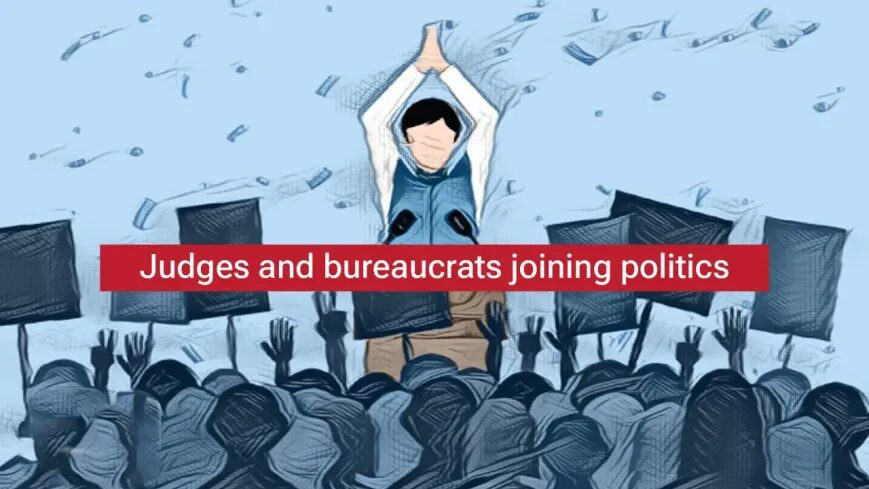
6.2 Immanuel Kant’s Deontological Ethics: Duty Above All
- Core Philosophy: Kant argued that morality is rooted in duty and universal moral laws. His ethical framework is deontological, meaning actions are judged by their adherence to rules, not their consequences.
- Categorical Imperative: A famous concept from Kant, this principle demands that actions be guided by maxims you would want universally applied.
- Example: Always tell the truth, because dishonesty undermines trust universally.
- Modern Relevance: Kantian ethics underpins modern judicial systems and governance frameworks, emphasizing impartiality and adherence to laws.
- Example: A judge delivering verdicts without bias or political influence reflects Kant’s principles.
6.3 Mahatma Gandhi’s Practical Ethics: Truth and Non-Violence
- Core Philosophy: Gandhi’s ethical vision was rooted in Satya (Truth) and Ahimsa (Non-Violence). He believed in the transformative power of moral courage and individual responsibility.
- Satyagraha: Gandhi’s method of non-violent resistance showcased how ethics could drive societal change. His approach emphasized self-discipline and prioritizing conscience over convenience.
- Modern Relevance: Gandhi’s ideals continue to inspire movements for justice and environmental sustainability.
- Example: The Chipko Movement, where villagers hugged trees to prevent deforestation, reflects Gandhian ethics.
Synthesis
- Aristotle teaches us to cultivate character, Kant stresses the importance of universal duty, and Gandhi exemplifies ethical action in the real world.
- Together, these thinkers provide a robust framework for ethical behavior that balances character, rules, and practical application.
7. Detailed Analysis of Determinants of Ethics
The determinants of ethics influence how individuals and institutions make decisions that align with moral principles. These determinants—personal, societal, and institutional—interact to create a framework for moral decision-making.
7.1 Personal Determinants
Ethics begins at an individual level, rooted in personal values, conscience, and upbringing.
- Values and Beliefs: Core principles like honesty, fairness, and compassion guide ethical behavior.
- Example: A teacher valuing equality ensures that all students receive equal attention, regardless of their background.
- Conscience: The inner voice that distinguishes right from wrong plays a critical role.
- Example: Whistleblowers often act on their conscience, exposing wrongdoing despite personal risks.
- Upbringing and Family Influence: Families instill foundational moral values that shape long-term behavior.
- Example: Parents emphasizing respect for elders influence children to adopt respectful attitudes throughout life.
7.2 Societal Determinants
Cultural norms, traditions, and social expectations influence ethical behavior.
- Culture and Religion: Societal ethics are often rooted in cultural and religious teachings.
- Example: The Indian ethos of “Vasudhaiva Kutumbakam” (the world as one family) promotes inclusiveness and global harmony.
- Peer Influence: The behavior of colleagues and friends shapes ethical norms.
- Example: In a workplace culture that values transparency, employees are less likely to engage in fraud.
- Education: Ethical education fosters critical thinking and moral reasoning.
- Example: Environmental ethics taught in schools encourage sustainable practices.
7.3 Institutional Determinants
Institutions and governance frameworks provide external ethical guidelines.
- Legal Frameworks: Laws establish baseline ethical standards.
- Example: Anti-corruption laws deter misuse of public resources.
- Codes of Conduct: Professional ethics guide behavior in specific fields.
- Example: The Hippocratic Oath ensures doctors prioritize patient welfare.
- Leadership: Ethical leaders inspire accountability and integrity in organizations.
- Example: Dr. A.P.J. Abdul Kalam’s emphasis on transparency and innovation exemplifies institutional ethics.
8. Frameworks for Resolving Ethical Dilemmas
Ethical dilemmas occur when individuals face conflicting values or interests. Effective frameworks provide structured methods to navigate these complexities, ensuring decisions align with moral principles.
8.1 Consequentialist Framework
- Core Idea: This approach evaluates the consequences of actions. An action is deemed ethical if it produces the greatest good for the greatest number.
- Example: During a pandemic, prioritizing healthcare resources for patients with the highest survival chances reflects consequentialism.
- Strengths:
- Ensures maximum benefit to society.
- Balances scarce resources effectively.
- Limitations:
- May overlook individual rights for collective welfare.
- Example: A project displacing marginalized communities for economic growth raises questions of justice.
8.2 Deontological Framework
- Core Idea: Actions are ethical when they align with rules, duties, or universal principles, regardless of outcomes.
- Example: Enforcing environmental laws even when it results in short-term economic loss reflects a deontological perspective.
- Strengths:
- Provides a clear moral compass by adhering to rules.
- Safeguards fundamental rights and justice.
- Limitations:
- Rigid adherence to rules may ignore practical realities or urgent needs.
8.3 Virtue Ethics Framework
- Core Idea: Emphasizes the moral character of the decision-maker over the action or its consequences. Focuses on cultivating virtues like courage, honesty, and empathy.
- Example: A leader prioritizing honesty during negotiations, even at personal cost, reflects virtue ethics.
- Strengths:
- Builds long-term trust in institutions and individuals.
- Promotes personal growth and ethical leadership.
- Limitations:
- Lack of clear guidance for resolving complex dilemmas.
8.4 Integrated Approach
- Core Idea: Many dilemmas require balancing consequentialism, deontology, and virtue ethics. This integrated approach leverages multiple frameworks to address ethical challenges comprehensively.
- Example: Allocating resources during a natural disaster:
- Consequentialism ensures the greatest benefit to the affected population.
- Deontology enforces fair distribution rules.
- Virtue ethics emphasizes compassion in decision-making.
9. Ethics in Specific Fields
Ethics manifests differently across various domains, addressing unique challenges while adhering to universal principles like fairness, justice, and sustainability.
9.1 Healthcare Ethics
- Core Principles:
- Autonomy: Respecting patients’ rights to make decisions about their own health.
- Beneficence: Acting in the patient’s best interests.
- Non-Maleficence: Avoiding harm.
- Justice: Ensuring equitable access to healthcare resources.
- Challenges:
- Balancing patient privacy with public health needs.
- Navigating ethical questions about end-of-life decisions like euthanasia.
- Modern Example: During the COVID-19 pandemic, healthcare professionals faced ethical dilemmas in allocating ICU beds and ventilators. Decision-making often required balancing justice (fair distribution) with beneficence (saving the most lives).
9.2 Environmental Ethics
- Core Principles:
- Sustainability: Meeting present needs without compromising future generations.
- Intergenerational Justice: Protecting natural resources for future generations.
- Intrinsic Value: Recognizing nature’s inherent worth beyond its utility to humans.
- Challenges:
- Conflicts between economic development and ecological preservation.
- Addressing climate change impacts while ensuring equitable policies.
- Modern Example: The Paris Agreement embodies global ethical commitments to combat climate change, balancing national interests with global welfare.
9.3 Technology Ethics
- Core Principles:
- Accountability: Ensuring responsible use of technology.
- Transparency: Preventing misuse by making processes clear.
- Fairness: Avoiding discrimination and biases in technological applications.
- Challenges:
- Ethical concerns around artificial intelligence (AI), such as biases in algorithms.
- Balancing privacy with security in surveillance technologies.
- Addressing the digital divide and ensuring equitable access to technology.
- Modern Example: The Cambridge Analytica scandal highlighted unethical data usage in influencing elections, raising concerns about privacy and accountability.
Conclusion
Ethics plays a vital role in shaping individual actions and institutional policies. By exploring historical perspectives from thinkers like Aristotle, Kant, and Gandhi, understanding determinants of ethical behavior, and employing structured frameworks, individuals can navigate complex dilemmas effectively.
Ethics in specific fields like healthcare, environment, and technology demonstrates its adaptability in addressing modern challenges. As societies evolve, ethics remains a cornerstone of justice, sustainability, and harmony, guiding humanity toward a more equitable and responsible future.


